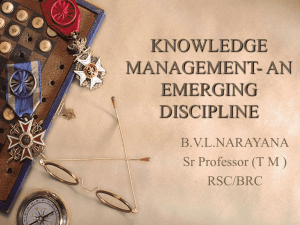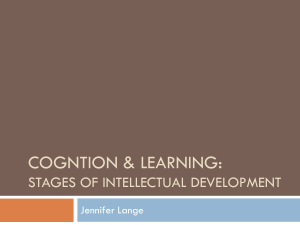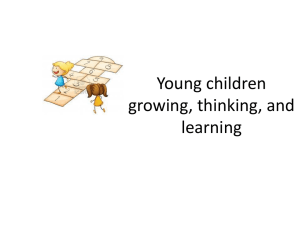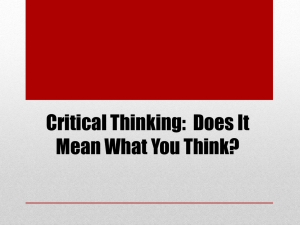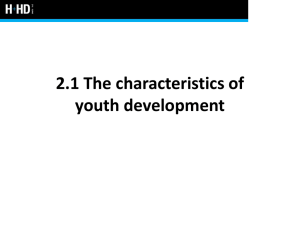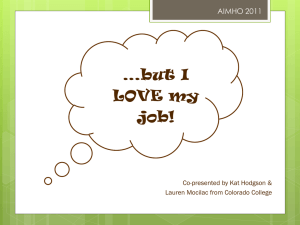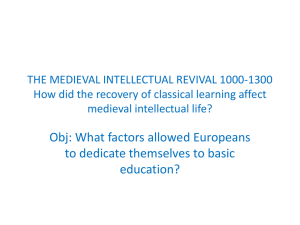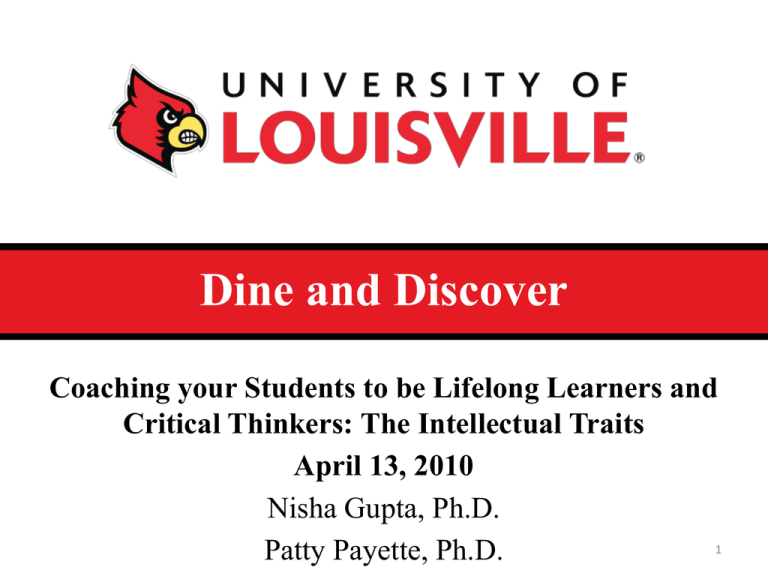
Dine and Discover
Coaching your Students to be Lifelong Learners and
Critical Thinkers: The Intellectual Traits
April 13, 2010
Nisha Gupta, Ph.D.
1
Patty Payette, Ph.D.
Review of the Goals
• Examine closely and work with the nine eight
Intellectual Traits as defined in the Paul-Elder critical
thinking framework.
• Explore, and reflect upon, how you can explicitly
promote these “habits of mind” in your students and
review examples of this work from your peers.
• Develop and discuss new learning outcomes and
activities that might support the development of
Intellectual Traits.
2
Before we begin…..complete a Focused Listing
List in words and phrases the kind of thinker you
want to students to become after completing
your course or program? What kinds of critical
thinking habits or dispositions should they
begun to internalize and master?
Ideas to Action (i2a)
and “Connecting the Dots”
“Our extensive consultation with all University constituencies
yielded a surprisingly strong and clear call for education focused on
the skills and knowledge needed to deal with real-world issues and
problems, an education in which students can see the importance
of the parts (the courses) to the whole (their education as citizens
and workers).” [QEP Proposal, 2007]
skills and
knowledge
real-world issues &
problems
the parts to the whole
http://louisville.edu/ideastoaction/files/finalreport.pdf
Focus on:
Share your words/phrases that you associate
with the thinkers you want your students to
become.
Focused Listing
Classroom Assessment Technique (CAT) #
• Focuses learner on a
single important term,
concept, name, idea
from the course and
asks them to
list/respond
• Helps learners recall the
most important points
• Assess what a learner
has retained or
assumptions/preconce
ptions and
misconceptions
• Small groups, class
discussion, exam
review
• Low stakes assessment
The Paul-Elder Framework
Intellectual Standards
Accuracy
Clarity
Relevance
Logic
Sufficiency
Precision
Depth
Significance
Fairness
Breadth
Intellectual Traits
Intellectual Humility Perseverance
Humility
Intellectual Perseverance
Autonomy Autonomy Empathy
Intellectual
Intellectual Empathy
Fair-mindedness
Intellectual
Fair-mindedness
Integrity
Intellectual Integrity
Courage Courage Confidence
Intellectual
Confidence in Reasoning
7
Intellectual Traits
• Traits of mind or cognitive habits
• Skilled thinking that does not manipulate others
or distort reality
• “Checks and balances” for our own thinking and
the thinking of others
• Intellectual traits guide us to be fair-minded
Intellectual
Disregard for
Justice
Distrust for
Reason
Intellectual
Laziness
Intellectual
Cowardice
Intellectual
SelfCenteredness
Intellectual
Arrogance
Intellectual
Hypocrisy
Traits of
the
Undisciplined
Mind
Intellectual
Conformity
Adapted from Critical Thinking: Learn the Tools the Best Teachers Use by Richard Paul and Linda Elder (p. 190)
Intellectual
Fairmindedness
Confidence in
Reasoning
Intellectual
Perseverance
Intellectual
Courage
Intellectual
Humility
Intellectual
Integrity
Intellectual
Empathy
Traits of
the
Disciplined
Mind
Intellectual
Autonomy
Adapted from Critical Thinking: Learn the Tools the Best Teachers Use by Richard Paul and Linda Elder (p. 190)
Intellectual Traits: Fundamental and
Powerful Concept
For many students, these concepts and behaviors
may be new to them.
They need support with
naming, exploring and
developing these skills.
p. 20: stages of critical thinking development
“Genuine intellectual development requires
people to develop intellectual traits…Skills,
values, insights, and intellectual traits are
mutually and dynamically interrelated. It is
the whole person who thinks, not some
fragment of the person.”
-Richard Paul
Critical thinking: how to prepare students for a rapidly changing world (1995)
Going deeper: Intellectual Traits
• Work in groups of 2
• Each take 4 Traits:
Empathy and Fairmindedness
Integrity and Humility
Courage and Perseverance
Autonomy and Confidence in Reasoning
• Quietly read and review your handout on the Traits and Miniature
Guide (p.14-15) and begin to grasp what that Trait is all about.
• Briefly summarize in your own words what it is.
• Close book, discuss with each other your understanding of your
respective Traits.
• Then together discuss and fill in:
Why is it significant for students to learn or cultivate this trait?
• What is the opposite of this trait? What does it look like when we
see this “opposite”?
What does the above teach us about critical thinking?
Conversely, how does critical thinking help illuminate the work
Finally, what implications does any of this have for instruction?
Traits Inventory
• Fill out with your Pov as an instructor
• Mark your top 3 strengths
• How did you cultivate this strength as a
thinker?
• Who and what situations or experiences
helped you develop these skills and
how?
Traits Inventory
Fill out this inventory with the point of
view of yourself as an instructor.
Coaching for these Traits
Setting expectations explicitly for you and your students: intentional choose
which Trait your assignments and course will cultivate. Consider revising your
course outcomes to reflect the Traits
Modeling and designing instruction to support that development
of that trait
Assessing for that trait: giving feedback verbally or a rubric or integrating Traits
into the evaluation or grading process
Burnet (pt. 1), Anthropology
The main vehicle for fostering these traits in the work of my
students will be the semester long research paper. This
assignment is broken down into numerous, small steps that
students will be required to complete throughout the
semester. This method will foster __Autonomy_________ by
leading students through the numerous steps of critical
thinking that go into producing a high-quality research paper
so that they know how to do it on their own in the future.
A.Intellectual Courage
B.Intellectual Autonomy
C.Confidence in Reason
Collins, Social Work
My job is to teach them how to bring about changes in individuals,
groups, and communities. Many of these changes are systemic
and may exceed individual choices or responsibilities. I will
challenge students to examine their own reasoning about the
rightness and wrongness of choices people make. This will foster
the intellectual trait of ___empathy_________.
A.Intellectual Integrity
B.Intellectual Empathy
C.Confidence in Reason
D.Intellectual Autonomy
Elhaj, Business
If the problem is not a replica, then remember that it will
not be solved in exactly the same way we did our
illustration. The solution is not going to be straightforward
in the sense of imitation. But do not give up too quickly.
This will require patience and _____________.
A.Confidence in Reason
B.Intellectual Perseverance
C.Intellectual Humility
D.Intellectual Courage
Faculty
member,
A&S
[This] can be cultivated in group discussions by
encouraging honest, open discussions and by requiring
students to support their opinions/positions with data
and to respect the supported positions of others.
This statement is related to a course assignment and reflects the
instructor’s desire to cultivate which two intellectual traits?
A.Confidence in Reason and Intellectual Humility
B.Fairmindedness and Intellectual Perserverance
C.Intellectual Humility and Intellectual Autonomy
D.Intellectual Courage and Confidence in Reason
Hayden, Justice Administration
I want the students to become consumers of research in the
criminal justice field. My first goal is for students to achieve
_________________ as they learn to read and comprehend
research studies. This trait is important to this course because of
the very nature of the field and topic. Criminal justice students
need to develop the ability to challenge the status quo and be
critical of the criminal justice system.
A. Fairmindedness
B. Intellectual Humility
C. Intellectual Courage
Mansfield-Jones, Anatomy & Physiology
Some barriers to understanding in anatomy and physiology are pre-existing misunderstandings
or erroneous beliefs. At their most obvious, these might be things like believing a "backbone"
is a single bone, or believing a media-driven impression that cholesterol is a toxin. A related
problem is and substitution of a broad generalization (balance, equilibrium) for deep
understanding. These have to be at least tentatively set aside to consider alternatives.
The instructor has identified an intellectual trait that she wishes to foster in
students in order to help them overcome the barriers to developing the
disciplinary thinking that she has described above. Which trait is it?
A.
B.
C.
D.
Confidence in Reason
Fairmindedness
Intellectual Humility
Intellectual Courage
Yohannes, English
I hope to cultivate ____________ by pushing
students to work with longer texts and with
the more involved research project.
A.
B.
C.
D.
Intellectual Integrity
Intellectual Perseverance
Intellectual Humility
Intellectual Courage
Red = elements
Blue = standards
Green = SW
traits604:
Wanda Collins
Skill-based course outcomes
1. Study, analyze, and evaluate social problems across multiple systemic
levels with individuals, families, groups, or community members.
(INTEGRITY)
2. Practice active listening without reference to one’s own feelings.
(EMPATHY)
3. Encourage people to come to their own conclusions. (AUTONOMY)
4. Identify solutions to problems through collaboration and input from
the client. (HUMILITY)
5. Exhibit fairness and respect to clients regardless of age, class, color,
culture, disability, ethnicity, family structure, gender, marital status,
national origin, race, religion, sex, and sexual orientation.
(FAIRMINDEDNESS)
6. Recognize the need to use supervision and consultation to increase
social work skills. (HUMILITY)
24
Strategies for fostering Traits
Setting expectations
• Be explicit with your expectations in writing and
verbally for the thinking you desire from students
• Model, model, model this thinking for them (idea #27)
(Brookfield and the hats)
• Label, label, label the thinking and “cognitive moves”
they do and you do with them
• Remind them that thinking skills can be cultivated
consciously with practice.
• Coaching
• “Think of yourself as a coach” essay (Ideas 18)
• Choose a specific Trait to focus on (Idea #29)
• Assessing
-Classroom Assessment Techniques (low-risk)
_Reflection papers
Confidence surveys
Traits Inventory
What does the above teach us about critical thinking?
Conversely, how does critical thinking help illuminate the work
Finally, what implications does any of this have for instruction?
Coaching slide
the Traits to coach students to work
toward a “master thinker”?
1. Setting expectations
2. Coaching/designing assignments to
promote intellectual Traits
3.
Metacognitive Reflection Questions & List of Strategies:
what will you do next?


